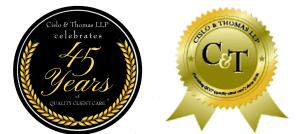Prepared by Cislo & Thomas LLP Attorney Mark D. Nielsen, Ph.D.
1. In My Health, Inc. v. ALR Technologies, Inc. et al., Magistrate Judge Roy Payne of the Eastern District of Texas denied a prevailing defendant’s “efforts” to hold the losing plaintiff’s lawyers and principal liable for a fee award against the plaintiff. The defendants prevailed in the case in a pretty clear Section 101 invalidity dismissal such that the case was described as “objectively weak.” A fee motion resulted in a determination that the case was “exceptional,” an award of fees, and an order requiring the fees to be paid within a specified amount of time. The plaintiff did not pay the fees, and one of the defendants filed a motion attempting to join the law firm representing plaintiff and the sole officer of plaintiff to the judgment, and thus, have them liable for the fee award as well. The basis for the motion was that the law firm and the sole officer of plaintiff were at least partially responsible for the filing of an exceptional, objectively weak case, and should be liable on the fee award. The court denied the motion because the joinder issue was not properly analyzed, the issue of altering the judgment was similarly not properly analyzed, and the defendant waived the issue of collecting the fee award from the law firm and sole officer of plaintiff because it was not previously raised in the exceptional case/fee motion. The Court similarly noted that the defendant would lose the issue on the merits as well. While this is generally good news for lawyers that happen to file weak, but non-frivolous cases. It appears that at least some of the denial of the relief sought was because of incomplete briefing of the joinder issue, and a failing to seek the relief sought in the original fee motion. Accordingly, one might expect greater efforts in the future to join law firms as responsible for a case being exceptional in the fee motion, rather than after judgment is entered.
2. In a recent case out of the Northern District of Illinois, the Court determined that using a number of video “snippets” of the 1985 Bears “Super Bowl Shuffle” video, as well as limited audio portions of the video, in a documentary about the 1985 Bears was a fair use under the Copyright Act. The opinion is here. Casting the accused use in the light of historical documentary, which it appears that it was, the Court found, among other things, that the limited use of the content (8 second of audio and 59 second of video broken up into 16 “snippets”) was historical commentary that differed in purpose from the purpose of the “Super Bowl Shuffle” video, the purpose of which was entertainment. The Court went through the four (4) fair use factors in 17 U.S.C. Section 107, and also noted that the documentary was not a substitute for the original video such that prospective consumers would purchase the documentary rather than the video, thus injuring the market for the video. Accordingly, the Court granted the defendants’ motion for summary judgment on fair use.
3. In what may constitute some level of “mixed-messaging” on Section 101 from the Federal Circuit, which continues to follow the Supreme Court’s Alice decision in large part, rather than steering its Section 101 jurisprudence towards the USPTO’s recent, more lenient approach to Section 101, the Federal Circuit reversed a district court determination of invalidity under Section 101 for two patents owned by Uniloc. The opinion is here. In essence, the Federal Circuit held that the two patents for which the Section 101 invalidity determination was reversed contained specific, particular steps in the claims that were an improvement over the prior art, and not known to be conventional at the time of patenting. While this is generally consistent with the Federal Circuit’s Section 101 jurisprudence, the 101 “universe” remains in significant flux with Congressional hearings taking place and the USPTO following one standard and the courts following another. Hopefully, clarity is on the way with a good possibility of a (gasp!) bipartisan bill to bring clarity to the ongoing Section 101 issues in the software and pharma contexts.



